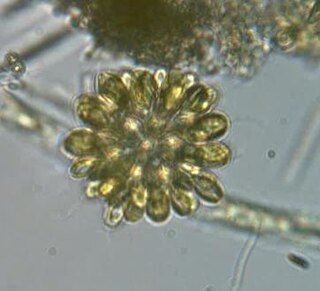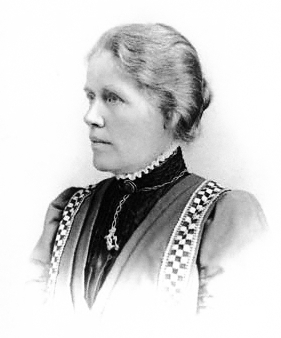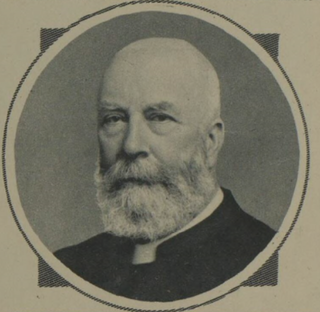Related Research Articles

The synurids are a small group of heterokont algae, found mostly in freshwater environments, characterized by cells covered in silica scales.

Gelsemiaceae is a family of flowering plants, belonging to the order Gentianales. The family contains only three genera: Gelsemium, Mostuea and Pteleocarpa. Gelsemium has three species, one native to Southeast Asia and southern China and two native to Central America, Mexico, and the southeastern United States. The eight species of Mostuea are native to tropical areas of South America, Africa, and Madagascar. The two genera were formerly classified in the family Loganiaceae. Pteleocarpa was originally placed in Boraginaceae or in its own family Pteleocarpaceae, but it is most closely related to Gelsemiaceae with which it shares significant characters.

John Gilbert Baker was an English botanist. His son was the botanist Edmund Gilbert Baker (1864–1949).
The history of phycology is the history of the scientific study of algae. Human interest in plants as food goes back into the origins of the species, and knowledge of algae can be traced back more than two thousand years. However, only in the last three hundred years has that knowledge evolved into a rapidly developing science.

The Field Elm cultivar Ulmus minor 'Sowerbyi', commonly known as the Sowerby Elm, was described by Moss in The Cambridge British Flora (1914). The tree, once referred to as the 'Norfolk Elm' by Smith, was commonly found in the hedgerows and woods of Norfolk, Cambridgeshire, and Huntingdonshire in the early 20th century before the advent of Dutch elm disease. Melville considered it a hybrid of 'Coritana'.

Anisopoda is a flowering plant genus with only one species: Anisopoda bupleuroides. The genus is in the Apiaceae and is endemic to Madagascar.

Eriospermum is a genus of tuberous flowering plants. It contains about 80-100 species, native to sub-Saharan Africa.
Professor Dianne Edwards CBE, FRS, FRSE, FLS, FLSW is a palaeobotanist, who studies the colonisation of land by plants, and early land plant interactions.

Corynocarpus is the only genus of plants in the family Corynocarpaceae and includes five species. It is native to New Guinea, Australia, New Zealand, New Caledonia, and Vanuatu.
Rolf Martin Theodor Dahlgren was a Swedish-Danish botanist and professor at the University of Copenhagen from 1973 to his death.
Uskiella is a genus of small fossil plants of Early Devonian age. The diagnostic characters are naked axes branching isotomously, terminating in ellipsoidal, vertically elongate flat sporangia which split longitudinally into two valves. Spores of U. reticulata have a reticulate appearance. Coalified specimens have been reported from Wales, with a possible occurrence in Australia.

Theodora Lisle Prankerd was a British botanist who worked on the growth of ferns, and lectured at Bedford College and the University of Reading.

Margaret Jane Benson was an English botanist specialising in paleobotany, and one of the first female members of the Linnean Society of London. Most of her career was spent as the head of the Department of Botany at Royal Holloway College, University of London from 1893 to 1922. In 1927, a botanical laboratory was dedicated in her name. She travelled extensively with Ethel Sargant, collecting specimens, laboratory equipment, and meeting other botanists around the world. Her students included Dame Helen Gwynne-Vaughan, Theodora Lisle Prankerd, Nesta Ferguson, and Emily Mary Berridge.

Paul Andries van der Bijl or alternatively Van der Byl was a South African mycologist known for his work on polypores or bracket fungi.
Mary Agard Pocock was a South African phycologist.

George Henslow was an Anglican curate, botanist and author. Henslow was notable for being a defender of Lamarckian evolution.

John Patrick Rourke FMLS is a South African botanist, who worked at the Kirstenbosch National Botanical Garden and became curator of the Compton Herbarium. He is a specialist in the flora of the Cape Floristic Region, in particular the family Proteaceae.
The British Phycological Society, founded in 1952, is a learned society based in the United Kingdom promoting the study of algae. Members interests include all aspects of the study of algae, including both natural biodiversity and applied uses. It is the largest learned phycological society in Europe. Its membership is worldwide, although predominantly within the UK.
James Stirton was a Scottish physician and one of Scotland's leading experts on cryptogamic botany. His investigations in bryology and lichenology earned him a world-wide reputation.
The Flore des Mascareignes is a flora, in French, covering the three islands in the Mascarenes: Réunion, Mauritius and Rodrigues.
References
- ↑ "Martin, Margaret Trevena (1905-) on JSTOR". Global Plants. JSTOR. Retrieved 6 December 2018.
- ↑ Newroth, P.R.; Taylor, A.R.A. (December 1968). "The distribution of Ceratocolax hartzii". British Phycological Bulletin. 3 (3): 543–546. doi: 10.1080/00071616800650161 .
- ↑ "Drew [married name Baker], Kathleen Mary (1901–1957), phycologist". Oxford Dictionary of National Biography. doi:10.1093/ref:odnb/94193 . Retrieved 25 March 2020.
- ↑ London, Linnean Society of (1937). Proceedings of the Linnean Society of London . Retrieved 6 December 2018.
- ↑ British Phycological Bulletin. 1960. p. 398. Retrieved 6 December 2018.
- ↑ Cleal, Christopher J; Pardoe, Heather S; Slade, Katherine; Whyman, Sally; Tangney, Raymond S; Jüttner Department, Ingrid (2021). "The Welsh National Herbarium". Botany Letters. 169 (1): 3–17. doi:10.1080/23818107.2021.1977178.
- ↑ International Plant Names Index. M.T.Martin.